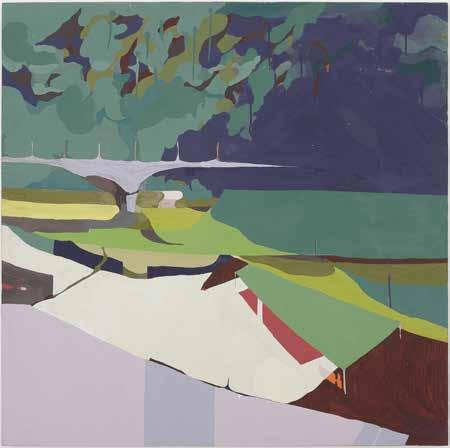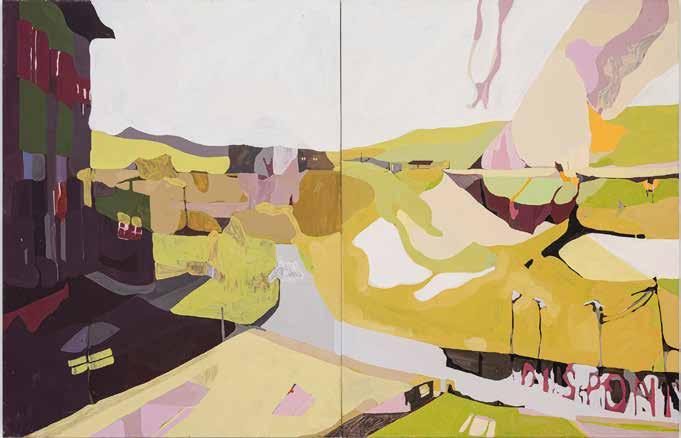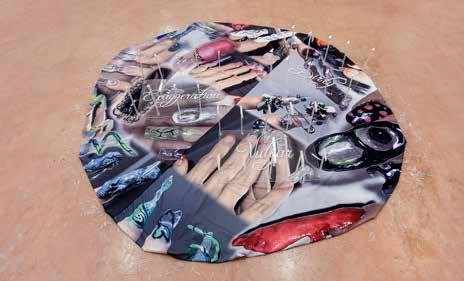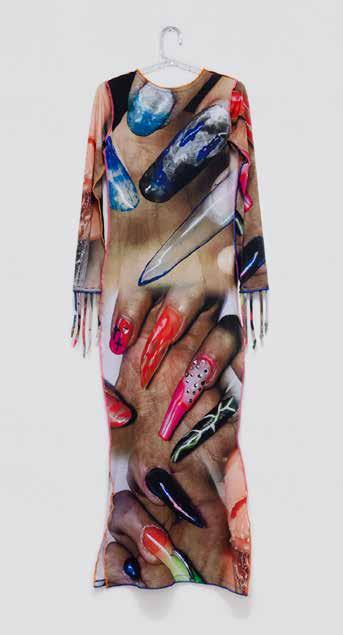
5 minute read
Clara Luz
A série Paisagem em desvio, de 2022, é composta de um conjunto de pinturas onde eu busquei, através do volume e da cor, criar paisagens que não se limitassem ao meramente figurativo. Se a tinta sobre o suporte pictorial é, afinal, um conjunto de manchas, volumes e linhas, a paisagem na qual acredito só poderia retratar a mancha, o volume e a linha. Minhas pinturas, embora remetam à paisagem, se referem, sobretudo, a elas mesmas. Para pintar as peças preferi o látex acrílico com corante líquido, não só para valorizar estes materiais, mas porque posso controlar as cores ao prepará-las. Trata-se de ser íntima da cor, pois é a cor o desvio da paisagem, o lugar, aquilo que a pintura informa.
The series Paisagem em desvio (Drifting Landscape), from 2022, is composed of a set of paintings where I sought, through volume and colour, to create landscapes that were not merely figurative. If paint on a pictorial support is, after all, a set of stains, volumes and lines, the landscape which I believe in can only portray the stain, the volume and the line. My paintings, although they refer to the landscape, refer, above all, to themselves. To paint the pieces, I chose acrylic latex with liquid dye, not only to enhance these materials, but because I can control the colours when preparing them. It is about being intimate with colour, because colour is the deviation from the landscape, the place, that which the painting informs.
Advertisement
Clara Luz (Bauru, 2000) vai à capital em 2019 cursar Artes Visuais na ECA-USP e se aprimora no campo da pintura. De 2020 a 2022 passa pelo 16º e 17º Salão Nacional de Arte Contemporânea de Guarulhos, 28° e 29° Programa Nascente USP. Seu trabalho explora a linguagem própria da pintura, em que manchas e volumes justapostos reproduzem imagens de sua memória. A criação e o controle de cores é procedimento primordial às obras, a partir da tinta látex acrílica junto ao corante líquido.
Clara Luz (Bauru, 2000) moved to the capital in 2019 to study Visual Arts at ECA-USP and trained in the field of painting. From 2020 to 2022 she presented her works at the 16th and 17th National Salon of Contemporary Art in Guarulhos, and in the 28th and 29th Nascente USP Programme. Her work explores the language of painting itself, in which juxtaposed spots and volumes reproduce images from her memory. The creation and control of colours is a primordial procedure for the works, in which acrylic latex paint is combined with liquid dye.

A obra gira em torno de três associações da unha no senso comum: vulgar, sujo e exagero. Tais associações são postas de forma negativa e demonstram um pré-julgamento muitas vezes baseado em questões de gênero, raça e classe, em que muitos defendem a ideia de uma beleza pura, limpa e padronizada. Através de uma instalação transdisciplinar, Cyshimi cria um conflito entre tais ideias pejorativas e as possibilidades de uma unha livre a partir de imagens de unhas esculturais. A artista subverte as tradicionais francesinhas com as frases “Somewhere you belong (Em algum lugar você pertence)”, “Be your teenage dream (Seja o seu sonho adolescente)” e “Reimagining the self (Reimaginando o Eu)”. O título Francesinha Reversa faz referência a mais usada técnica de francesinhas em alongamentos de unhas, ao mesmo tempo em que alude à subversão e contraposição de elementos da obra. Ao longo de sua pesquisa, as unhas representam uma nova visão de mundo, uma nova possibilidade de ser, e a partir dessa nova possibilidade, há uma ruptura de ideias hegemônicas de beleza e de estilo de vida. Suas esculturas de unha são, ao mesmo tempo, reais e surreais - são sobre corpo, identidade e sobre se reimaginar.
The piece revolves around three associations of nails in popular culture: they are either vulgar, dirty or an exaggeration. Such associations are posed negatively and demonstrate a pre-judgement often based on gender, race and class biases, where many hold the idea of a pure, clean and standardized beauty. Through a transdisciplinary installation, Cyshimi creates a conflict between such pejorative ideas and suggests new possibilities for free nails, based on images of sculptural nails. The artist subverts the traditional French nail-do with the phrases “Somewhere you belong”, “Be your teenage dream” and “Reimagining the self”. The title Reverse French Nails makes reference to the most used French-do technique in nail lengthening, while also alluding to the subversion and counterposition of elements in the work. Throughout her research, nails represent a new worldview, a new possibility of being, and from this new possibility, there is a rupture of hegemonic ideas in beauty and lifestyle. Her nail sculptures are at the same time real and surreal - they are about body, identity and about reimagining oneself.
Indumentária da performance Roupa de Treino I e Roupa de Treino II. Essa obra expõe a representação de unhas de treino em um elemento vestível, representado pelo vestido de gala - que representa luxo e opulência - e através dos rituais e processos das primeiras construções de alongamento de unha na tal fase de “treinamento” realizado pela artista. Percebemos uma inversão e deslocamento de sentido, quando colocamos esses dois elementos em jogo: a formalidade e a ostentação do vestido de gala e o lugar em que o treino de manicure é colocado no imaginário do senso comum, como algo a ser escondido e oculto até que o resultado do alongamento seja impecável.
Clothing from the performance Roupa de Treino I and Roupa de Treino II (Training Clothes I and Training Clothes II). This work exposes the representation of training nails in a wearable element, a gala dress - the embodiment of luxury and opulence - and through the rituals and processes of the first nail lengthening constructions in such a “training” phase performed by the artist. We perceive an inversion and displacement of meaning when we put these two elements into play: the formality and ostentation of the gala dress and the place in which manicure training is located in the popular imagination, as something to be hidden and concealed until its results are impeccable.
Roupa de Treino I [Training Clothes I], 2020 / tecido sublimado e unhas em acrílico [sublimated fabric and acrylic nails] / 150 x 50 x 3 cm [59 x 19 3/4


Reverse French Nails (Francesinha Reversa), 2022 / instalação | unhas postiças, acrílico e tecido [installation | fake nails, acrylic and fabric] / 230 x 230 cm [90 1/2 x 90 1/2 in]
Artiste Transdisciplinar, brasileire de ascendência chinesa e taiwanesa. Sua pesquisa permeia questões de ancestralidade, identidade, corpo e beleza através de performance, instalação, arte digital e esculturas de unhas. Para Cyshimi, unhas são Esculturas Performáticas, termo cunhado pela artista que afirma que suas unhas não são apenas um objeto estático, mas uma escultura que molda a performatividade dos corpos. Elas são um símbolo de resistência, empoderamento e identidade. Cyshimi vê cada unha como um mundo novo, construído por formas, cores e texturas que, quando em conjunto, atravessam quem as usa e quem as vê. Esteve em instituições como CCSP, Parque Lage e Instituto Adelina. Mencionade em plataformas como Instagram, Dazed Beauty e Metal Magazine.
Cyshimi is a Brazilian transdisciplinary artist of Chinese and Taiwanese descent. The artist’s research is permeated by questions of ancestry, identity, body, and beauty through performance, installation, digital art and fingernail sculptures. For Cyshimi, fingernails are Performing Sculptures, a term coined by the artist that affirms that her nails are not just static objects, but sculptures that shape the performativity of bodies. They are a symbol of resistance, empowerment and identity. Cyshimi sees each fingernail as a new world, composed of shapes, colours and textures that, taken together, influence those who wear them and who see them. The artist attended institutions such as CCSP, Parque Lage and Instituto Adelina. Cyshimi is mentioned on platforms such as Instagram, Dazed Beauty, and Metal Magazine.










